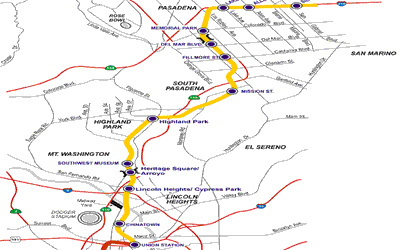 Today is the 5th Anniversary of the July 25, 2003 public opening of the Pasadena Gold Line. This is the Construction Authority's poster.
Today is the 5th Anniversary of the July 25, 2003 public opening of the Pasadena Gold Line. This is the Construction Authority's poster.Here are some photos from opening weekend and pre-opening testing. (Click photos to enlarge)
 MTA Board members spoke before this huge banner in Union Station's ticketing hall for the Friday preview opening. (7/25/03)
MTA Board members spoke before this huge banner in Union Station's ticketing hall for the Friday preview opening. (7/25/03) At Union Station I helped direct some of the over 70,000 people who rode both Saturday and Sunday. (7/26/03)
At Union Station I helped direct some of the over 70,000 people who rode both Saturday and Sunday. (7/26/03)
It was remarkable, such a cross-section of Los Angeles: all races, and families with all ages, from babies in strollers to seniors with canes or in wheelchairs, all waiting patiently to ride the trains. (7/26/03)
 After an aerial section the next station is Chinatown, shown here during pre-opening testing. (4/03)
After an aerial section the next station is Chinatown, shown here during pre-opening testing. (4/03) A test train crosses the new Los Angeles River bridge. The maintenance yard is out-of-frame to the left. (4/03)
A test train crosses the new Los Angeles River bridge. The maintenance yard is out-of-frame to the left. (4/03) This is the half-mile section along Marmion Way in Highland Park where trains run at 20 mph with signal priority. The rest of the line is 55 mph with gated crossings or grade separations for a high 28 mph average speed for this 13.7-mile line. (4/03)
This is the half-mile section along Marmion Way in Highland Park where trains run at 20 mph with signal priority. The rest of the line is 55 mph with gated crossings or grade separations for a high 28 mph average speed for this 13.7-mile line. (4/03) Families with kids at the Highland Park station on opening day. (7/26/03)
Families with kids at the Highland Park station on opening day. (7/26/03) South Pasadena station with a train on display before opening. One of these women said, "It's like we're a real city!" (4/03)
South Pasadena station with a train on display before opening. One of these women said, "It's like we're a real city!" (4/03) Leaving the station the tracks cross Mission Street in historic South Pasadena. The celebrated New Urbanist transit-oriented development Mission Meridian Village is behind the brick building on the left. (4/03)
Leaving the station the tracks cross Mission Street in historic South Pasadena. The celebrated New Urbanist transit-oriented development Mission Meridian Village is behind the brick building on the left. (4/03) The Memorial Park station in Old Town Pasadena was built on the existing right-of-way in space set aside beneath the Holly Street Apartments. (7/25/03)
The Memorial Park station in Old Town Pasadena was built on the existing right-of-way in space set aside beneath the Holly Street Apartments. (7/25/03) The last three stations are in the median of I-210 in Pasadena. (7/26/03)
The last three stations are in the median of I-210 in Pasadena. (7/26/03) Recent Gold Line ridership has been over 23,000 average weekday boardings.
Recent Gold Line ridership has been over 23,000 average weekday boardings.



































